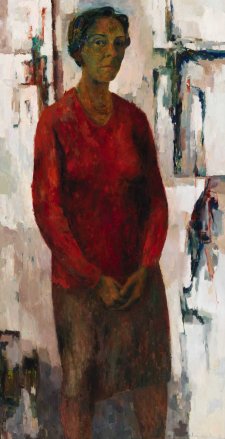- About us
- Support the Gallery
- Venue hire
- Publications
- Research library
- Organisation chart
- Employment
- Contact us
- Make a booking
- Onsite programs
- Online programs
- School visit information
- Learning resources
- Little Darlings
- Professional learning
Grace Cossington Smith OBE is from the generation of women artists now largely credited with introducing modern art to Australia. Her painting The sock knitter (1915), with its flattened picture plane, strong formal qualities and use of vivid colours, is considered the first post-impressionist painting exhibited in this country. During the 1920s Cossington Smith developed her distinctive mosaic-like style by which forms were translated into intricate, rhythmic squares and strokes of colour and light. In the same period she commenced her exhilarating series of paintings of the Sydney Harbour Bridge under construction.
By the time this 1948 self portrait was painted, Cossington Smith had moved from her garden studio at the family home in Sydney’s Turramurra to one inside the house, resulting in the shimmering paintings of interiors which are characteristic of her later work. Depicting herself in the prime of her long career, the short brushstrokes, laden with paint, build up a strong colour portrait and capture the dedication she felt towards her art in her intense focused gaze and the determined set of her lips.
Purchased 2002
© Estate of Grace Cossington Smith
This self-portrait of the painter Grace Cossington Smith, was made in 1948, with oil on cardboard, and measures 57cm high and 48cm wide. The prominent frame is dark wood, and between it and the painting is a second, narrow, inner frame of bone coloured canvas.
The dynamism in this portrait comes from the way it has been painted - with small, squarish, paint-laden brush strokes in warm yellows and browns, that seem to flicker and move – dancing across the surface of the canvas. In contrast, Grace appears rather quiet and unremarkable, looking out, through round rimmed glasses, and dressed in a collared shirt.
Grace’s head and upper torso dominate the portrait. Behind her, the top half of the painting shows a light filled, green and yellow dappled background, while the bottom half is mostly darker tones, and includes a warm, deep-brown coloured object – possibly the back of a chair.
Grace has cropped hair, parted at the centre, and tucked behind her ears. Though it is neat, there is the impression of a wavy texture - created through layered brush strokes in mottled copper-browns, yellow-greens and deep-blues. Grace’s oval face is tilted slightly up, and the right side is angled to the viewer, with light falling on it. Her forehead is high, rounded and smooth. Grace’s eyebrows are obscured by her slender, brown-framed, round-rimmed glasses.
Through the lenses, Grace’s gaze is striking – her eyes are brown and almond shaped, and their look is direct; unfaltering. Perhaps the intense stare is aimed at the viewer, or perhaps at herself, as she works on her portrait, scrutinising her reflection in a mirror.
Grace has a straight nose. Her natural-pink lips are pursed, and set in a serious expression.
A pink brush stroke defines the curve of Grace’s small, round chin. Three brown flecks give shape to the right side of her jaw, and vertical, smudged dabs in yellow-brown and pink, allude to the slackening skin of the neck of a woman in her mid-fifties.
The collar of Grace’s shirt fits close to her neck, and comes together in a ‘v’. On Grace’s right side, where the light touches it, the front of her shirt is painted in whites, pale pinks and browns, while on her left side, deep reds and patches of dark blue-green indicate shadows.
The bottom edge of the portrait crops Grace off mid-chest. In the left corner, beneath the short sleeve of her shirt, is her bare right arm.
In front of Grace’s left shoulder, in the lower right corner of the painting there are three flat, rectangular shaped objects layered against each other. The objects’ shapes and positions suggest they are the yellow backs of two cardboard canvasses leaning against a brown, timber easel.
Audio description written by Lucie Shawcross and voiced by Emma Bedford
Grace Cossington Smith OBE (age 56 in 1948)



On one level The Companion talks about the most famous and frontline Australians, but on another it tells us about ourselves.



Jean Appleton’s 1965 self portrait makes a fine addition to the National Portrait Gallery’s collection writes Joanna Gilmour.



Close contemporaries, Thea Proctor, Margaret Preston and Grace Cossington Smith were frequently sources of inspiration and irritation to each other.